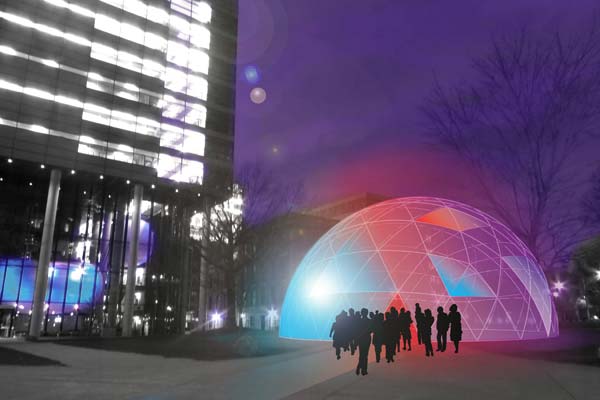
An artist's rendering of the My Virtual Dream dome at Scotiabank Nuit Blanche
Art + Science + Technology = Virtual Dreams and Healthy Brains
U of T and Baycrest scientists join with artists to transform brain health, Toronto streets, at Scotiabank Nuit Blanche
Published: October 4, 2013
People attending Nuit Blanche in Toronto this Saturday will have an opportunity to experience ground-breaking neuroscience research led by University of Toronto and Baycrest Health Sciences through My Virtual Dream.
One part art exhibit, one part science experiment, this installation brings together art, science and technology by synchronizing brain waves to create a multi-sensory experience—a virtual dream—inside a 60-foot dome. (See video preview at bottom of article.)
“My Virtual Dream allows for people from different disciplines and industries, both in arts and science, to come together to unlock brain’s potential and find cure for neurological diseases,” said Alison Buchan, Vice Dean of Research and International Relations in U of T’s Faculty of Medicine.
My Virtual Dream will make the newest technologies in neuroscience available to the general public. “Community involvement and outreach is a big part of our mandate at the Faculty of Medicine. This exhibit is a great way to engage the general public in our scholars’ projects,” said Buchan.
Nuit Blanche visitors will connect their brain waves to The Virtual Brain, a research tool that replicates the complex functions of a human brain. By relaxing or concentrating, The Virtual Brain will record participants’ brain waves which will in turn alter images appearing on the walls of the dome and create their very own dream.
“What would you say to your own brain if you could talk to it?” is just one of the philosophical questions Randy McIntosh asked when he began work on this exhibit.
McIntosh is a Professor in U of T’s Institute of Medical Science, Vice-President of Research at Baycrest Health Sciences and Director of Baycrest’s Rotman Research Institute. He aims to develop software based on The Virtual Brain that would interpret brain activity and help doctors better understand how a patient’s brain has been damaged by dementia, epilepsy, stroke and other disorders, pointing to more effective, targeted treatments.
“We are only starting to understand how to interpret the brain activity and how we could use it in practice. It is exciting for us to collaborate with artists on the My Virtual Dream project as together we can inspire people of all backgrounds to become aware of the brain’s potential and contribute to our research,” said McIntosh.
My Virtual Dream premiers at Scotiabank Nuit Blanche on October 5 at 7 p.m. and ends at 7 a.m. on October 6 at the corner of University Avenue and College Street.



